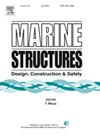边弯法、双半径弯法和反向弯法生产的ERW管材尺寸加工过程中抗塌性能的提高
IF 5.1
2区 工程技术
Q1 ENGINEERING, CIVIL
引用次数: 0
摘要
石油、天然气和衍生品海上运输需求的不断增长需要高性能的管道基础设施。通过冷成形工艺制造的电阻焊管已成为海洋管道系统的基石。本研究采用ABAQUS软件进行序贯数值模拟,对管道成形过程进行建模,并对海上管道的关键设计参数——崩溃压力进行预测。对三种成形方法进行了建模:反向弯曲成形、双半径成形和边缘成形,并针对每种工艺定制了辊子几何形状。本构模型集成了循环拉压加载,结合了包辛格效应和应变硬化,以精确地表示材料。通过不同施胶比和厚径比分析了施胶阶段对管材制造的影响。结果表明,无论采用何种成形方法,较高的施胶比都能均匀地提高管道的坍塌压力,特别是在t/D值较大的管道中。在各种成形方法中,反向弯曲成形始终能生产出具有优良抗折性能的管材。参数研究进一步探讨了椭圆度和应力历史对不同施胶比下坍塌压力增强的影响。本文章由计算机程序翻译,如有差异,请以英文原文为准。
Collapse performance enhancement in the sizing process of ERW pipes produced using edge, double radii, and reverse bending methods
The rising demand for offshore transportation of oil, gas, and derivatives necessitates high-performing pipeline infrastructure. Electric resistance welded pipes, manufactured through cold-forming processes, have become a cornerstone for offshore pipeline systems. This study employs sequential numerical simulations in ABAQUS to model the pipe-forming process and predict collapse pressures—a pivotal design parameter for offshore pipelines. Three forming methods were modeled: reverse bending forming, double radii forming, and edge forming, with roller geometries tailored to each technique. The constitutive model integrated cyclic tension-compression loading, incorporating the Bauschinger effect and strain hardening for precise material representation. The impact of the sizing stage in the pipe manufacturing was analyzed through different sizing ratios and the thickness-to-diameter ratio. Results demonstrated that higher sizing ratios uniformly enhance collapse pressure regardless of the forming method, particularly in pipes with larger t/D values. Among the forming methods, reverse bending forming consistently produced pipes with superior collapse performance. Parametric studies further explored the influence of ovality and stress history on collapse pressure enhancement across sizing ratios.
求助全文
通过发布文献求助,成功后即可免费获取论文全文。
去求助
来源期刊

Marine Structures
工程技术-工程:海洋
CiteScore
8.70
自引率
7.70%
发文量
157
审稿时长
6.4 months
期刊介绍:
This journal aims to provide a medium for presentation and discussion of the latest developments in research, design, fabrication and in-service experience relating to marine structures, i.e., all structures of steel, concrete, light alloy or composite construction having an interface with the sea, including ships, fixed and mobile offshore platforms, submarine and submersibles, pipelines, subsea systems for shallow and deep ocean operations and coastal structures such as piers.
 求助内容:
求助内容: 应助结果提醒方式:
应助结果提醒方式:


